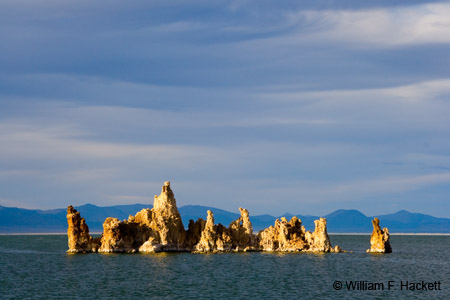Mono Lake

Mono Lake is an alkaline and hypersaline lake that is east of Tioga Pass and near the California town of Lee Vining. The lake is an unusually productive ecosystem and provides critical nesting habitat for several species of birds. I wrote about my trip to photograph Mono Lake here.
Mono Lake is apparently at least 760,000 years old and dates back to the Long Valley Eruption. Mono Lake is a terminal lake in a watershed that is fed with the runoff from melting snow. Dissolved salts in this runoff raise the pH of the lake and increase the concentration of salts. Volcanic activity continues in the basin. The most recent eruption was 250 years ago at Negit Island in Mono Lake.
Early people of Mono Lake were called the Kutzadika’a, who were the Yosemite-Mono Lake Paiutes. These people foraged the larvae (called kutsavi in their language) of the alkali flies of the area. Although the origin of the term “Mono Lake” is unknown, “Mono” is apparently a Yokut term for “fly eater.”
I have blogged that California is very much about water, and probably always will be. In the past, to provide water for the growing Los Angeles area, water was diverted from the Owens River. The Los Angeles Department of Water and Power extended an aqueduct system into the Mono Basin in 1941. So much water was diverted that evaporation from the lake soon surpassed the inflow of water from melting snow, and the lake level steadily dropped. By 1982, the lake was reduced to 31% of its 1941 surface area (down to 37,688 acres (152.2 square km). Negit Island became a peninsula and the nests of gulls were exposed to predators, largely coyotes, so that gulls abandoned Negit Island as a nesting site. Submerged towers of tufa became exposed, and are still exposed (1, 2, 3, 4, 5, 6, 7).
A University of California, Davis graduate student, David Gaines, earned his master’s degree in 1976 by studying the Mono Lake ecosystem and informed the public of the effects of lower lake levels. He formed the Mono Lake Committee in 1978 and joined with the Audubon Society to fight a court battle to protect Mono Lake. The California State Water Resources Control Board issued an order to protect Mono Lake and its tributaries on September 28, 1994. Since that time, the lake level has risen steadily. The elevation of the lake surface was at 6417 feet (1956 m) above sea level in 1941, 6385 feet (1946 m) in 2000, and the goal is 6392 feet (1948 m).
No fish are native to Mono Lake, which is hypersaline and has a pH of 10. However, the lake hosts the Mono Lake brine shrimp, Artemia monica, a tiny species that is found nowhere else on earth. During the summer, an estimated 4-6 trillion brine shrimp inhabit the lake and feed on microscopic planktonic algae that are fertilized by winter and spring runoff and turn the lake green by March. The alkali fly, Ephydra hians, is also an important food source. Mono Lake is a critical rest stop for migrating shorebirds and has been recognized as an internationally important site. Nearly 2 million waterbirds, including 35 species of shorebirds use Mono Lake at least part of the year. Some of the bird species are: sandpipers, Kildeer, American avocets, eared grebes, and phalaropes.
Mark Twain‘s “Roughing It” (1872) describes Mono Lake in its natural condition. The lake and surrounding mountains also figure prominently as the setting for the town of Lago in the 1973 film, “High Plains Drifter“, starring Clint Eastwood. The film was shot on location on the shores of Mono Lake.
-Bill at Cheshire Cat Photo™
You can view higher-resolution photos (*generally* 7-30 megabytes, compressed) at the Cheshire Cat Photo™ Pro Gallery on Shutterfly™, where you can also order prints and gifts decorated with the photos of your choice from the gallery. Apparel and other gifts decorated with some of our most popular photos can be ordered from the Cheshire Cat Photo™ Store on CafePress®. Both Shutterfly™ and CafePress® ship to most international locations worldwide!







